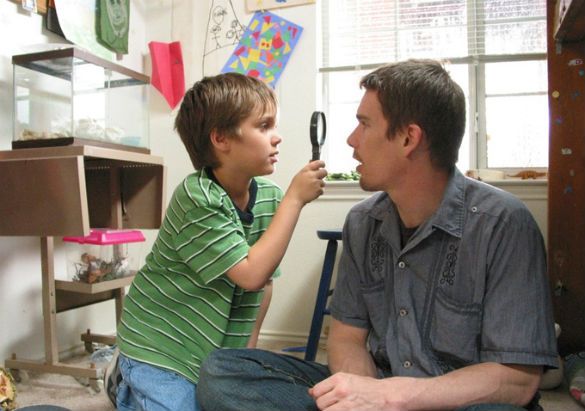“Boyhood” encapsulates the magic of growing up
September 25, 2014
“Boyhood” is both the least and most daring film Richard Linklater has ever made. The “Before” trilogy was a contemplative statement on relationships, but while the individual films were very good, the three must be approached as a collective effort to understand their ambition. There’s impressive camera work in “School of Rock,” but the story is not universally relatable like that of Linklater’s latest, which is his best yet; the filmmaking and the story are both important.
“Boyhood” encapsulates the childhood and adolescence of Mason Jr. (Ellar Coltrane) as he progresses from first grade through college. It is the least daring Linklater film because the plot involves nothing more than life itself. At the same time, however, it was filmed over a span of 12 years, shot gradually for a few days each year. And this makes it quite daring. Many things could have gone wrong in production; maybe Coltrane’s acting skills would have lessened during adolescence, and the movie would have succumbed to a poor lead actor. Maybe an actor would wake up one day and want to pull out of the whole project.
Thankfully, neither of these two scenarios played out, and the result is a movie that runs the gamut between humorous, sad and hopeful. While some scenes are depressing, they are balanced out with its large amount of comic relief, which is almost never just meaningless comedy. Much of it is relevant to its time. In what the audience can presume is 2007, an angry man hanging a Confederate flag outside his house asks Mason if he “looks like a Barack Hussein Obama supporter” and warns he could shoot Mason for being on his property. In most likely 2013, Mason half-jokingly makes a prediction about NSA surveillance. And Mason, Sr. criticizes his daughter’s school for calling the Iraq War “a good war.” The screenplay’s incorporation of politics and real-life events is respectable.
It’s also worth mentioning “Boyhood” is two hours and 45 minutes, yet does not drag on. All sequences show the characters’ growth, so no scenes are superfluous. The film will likely be frequently mentioned among the Academy for Best Film Editing, along with more honorary awards. The decision to show a “2007” title screen, followed by a “2008” title screen 20 or so minutes later, could have been made, but “Boyhood” benefits from a less straightforward editing choice: scenes melded with little indication of age/time. There are simply musical cues and other light hints on setting. Vampire Weekend fans may know the song accompanying the “Barack Hussein Obama” sequence was “One (Blake’s Got a New Face)” off their 2007 debut album. And “Suburban War,” featured later, appears on Arcade Fire’s “The Suburbs.” This editing makes the experience of watching the film more lifelike. Rather than spoon-feed the viewer, everything depicted simply happens, as it does in reality.
The cinematography and camera work in “Boyhood” is also worthy of praise. A scene in which Mason drinks with his friends is set at night. The scene’s darker setting is interesting in terms of filmmaking and mise en scene. These young men, drinking alcohol and having recently discovered girls, are different from who they were as children. Most scenes before this take place in the daytime, whereas this sequence’s darkness is an apt visual cue. It juxtaposes with the loss of innocence made evident in the boys’ actions.
In another inspired scene, Mason and Samantha’s mother, Olivia, is crying face-down on a garage floor, away from their stepfather standing next to her– domestic violence implied. The garage is unlit, and the door is halfway open so he is visible from the waist down only, which makes the scene more emotionally affecting: when we think of someone, we generally think of his or her face. Exclusion of facial features is disorienting and emphasizes his authoritarianism. In addition, the dark garage contrasts from the daylight outdoors.
I did not expect “Boyhood” to be this invigorating. In less than three hours, we see two people grow from young children to college students. Ultimately, I rank it with the best, and most significant, films of the past decade. It may be among the first true coming-of-age movies, because no others come close to replicating the scope – and no others span a protagonist’s entire childhood with half the accuracy. So is it time we created a new genre? The distance between “Boyhood” and all other coming-of-age movies is comparable to the distance between “The Searchers” and all other westerns, or between “2001: A Space Odyssey” and all other science-fiction. Is it as good as either of these two? No, not even close. But it arguably breaks just as much new ground for its genre. Both the editing , camerawork, and Linklater’s direction make the film realistic and lifelike. I can think of only one coming-of-age film, not counting the mislabeled as coming-of-age “Moonrise Kingdom,” intrinsically better than “Boyhood,” and that would be “The 400 Blows,” a movie which first came out 54 years ago to greet the French cinemas of 1959.


